When Joe Strummer sang, “Should I stay or should I go?” he quickly answered his own question using basic math: if he stays, there will be trouble; if he goes, it will be double. For non-rock-stars with regular jobs, the odds are rarely so clear-cut.
The era of the job-for-life is long behind us. But job-hopping as a trend is also at least two generations old, with “churn flow” peaking in the 1990s following the mass layoffs of the ‘80s. The gig economy has already lost its utopian sheen. And with lockdown behind us and the AI revolution unfolding, nobody’s quite sure what’s best to do next.
You can see why job-hopping appeals. A range of successfully completed contracts doesn’t just show that you’re adaptable — it trains you to be adaptable, socially and technically, in turbulent times. But that broad network and skillset may come at the expense of deeper knowledge and connections. “An employee moving jobs too often can mean they aren’t in a position long enough to truly learn the role or gain new skills,” says Lauren Thomas, European economist at Glassdoor. “It can ultimately damage a person’s career: it may be challenging to demonstrate to a new employer previous proficiency and achievements.”
Ultimately, the decision of how long to stay at a job should be made strategically. It depends on the context of the jobs you’ve done to date and your ambitions for the mid- and long-term future — and it is rarely advisable to job-hop just for a wage increase. Other factors to consider include the industry and the town or city in which you work. So, Resume.io set out to find the places in the U.S., UK, Australia and Canada where people job-hop the most — and the cities where workers are the most loyal.
What We Did
Resume.io analyzed LinkedIn data from the most populated cities in the U.S., UK, Australia and Canada. We identified all currently employed LinkedIn users with less than one year (“job-hoppers”) or more than 10 years (“loyal”) with their current company.
Key Findings
- Berkeley, California, is the job-hopping capital of the U.S., with 19.23% of the workforce switching jobs in the past year.
- Rochester, Minnesota, has the most loyal employees, with 33.33% having been at the same company for over 10 years.
- The UK’s most fickle employees are in Manchester (20.87% under one year), and the most loyal are in Preston (23.21% over 10 years).
- Australia’s job-hopping capital is Brisbane (18.61% under one year), and its job-for-life capital is Newcastle, New South Wales (20.51% over 10 years).
- Canada’s most short-lived jobs are in Vancouver (20.50% under one year), and its lengthiest stays are in Ottawa (27.22% over 10 years).
Berkeley leads U.S. job-hopper cities driven by head-hunter tech culture
With its proximity to Silicon Valley, the city of Berkeley, California, leads a raft of tech hub cities with the highest employee turnovers in the United States. Job-hopping has long been the cultural norm in the IT industry. At its best, this constant rotation of talent is thought to drive innovation and strengthen the most promising companies within a tight cluster of tech firms — one 2018 figure suggested that millennials in Silicon Valley swap jobs at twice the average national rate.
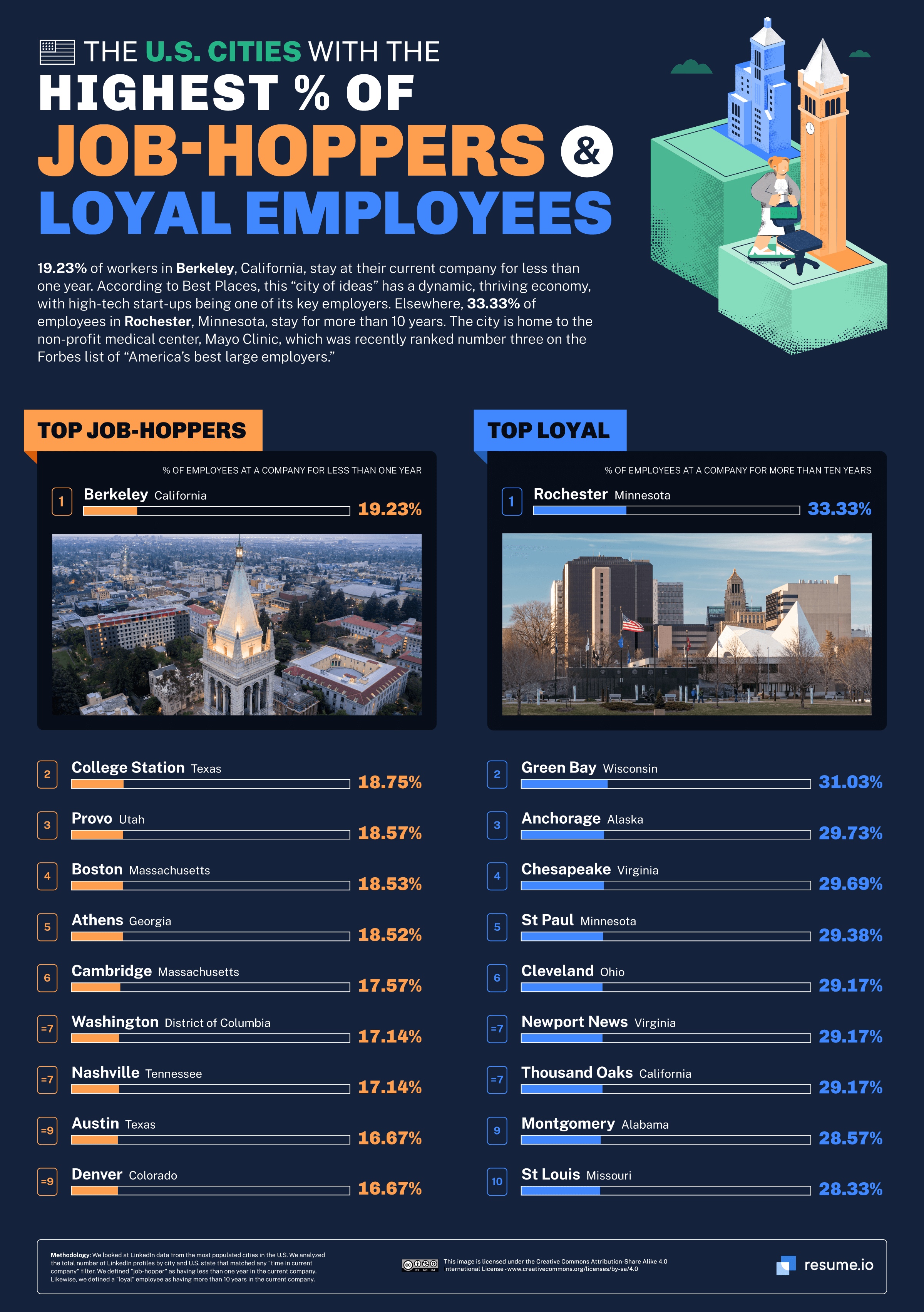
Click here to see the image in full size
However, the job-hopping trend may also be stifling smaller start-ups and creating unfair disparities between employees of the same company. “To have one of your top engineers come back and re-trade two years in because they have a super competitive offer — it’s really hard to manage, and I think we’re seeing a decent amount of that because the market has changed so quickly,” says Katie Hughes, executive talent head of General Catalyst.
Southern and midwest employees are America’s most loyal
Employers define job-hoppers as those with a track record of leaving jobs after no more than a year or so — although “there’s nothing magical about the one-year mark!” explains career advisor Alison Green. “If you leave four jobs in a row after 18 months each, you’re going to look pretty job-hopper-ish.” A pattern like this on your resume is hardly designed to inspire potential bosses to invest in your future — but it depends very much on what part of the country you’re in.
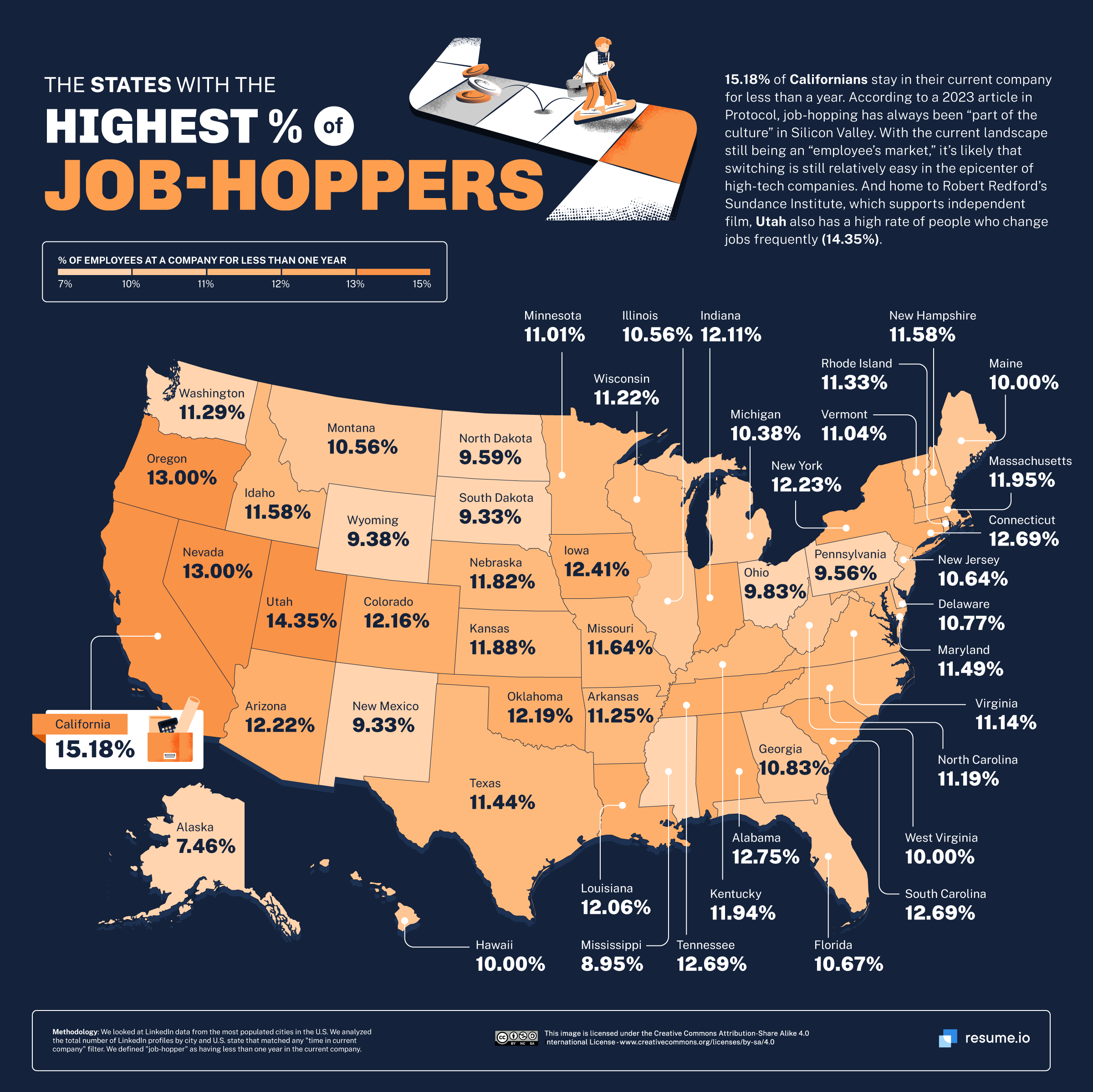
Click here to see the image in full size
California’s dynamic tech and creative industries are among the drivers of a high-turnover workforce — the highest in the States. Indeed, job-hopping is a veritable “California right,” with courts historically taking the job-hopper’s side in disputes and non-compete agreements “void” within the state.
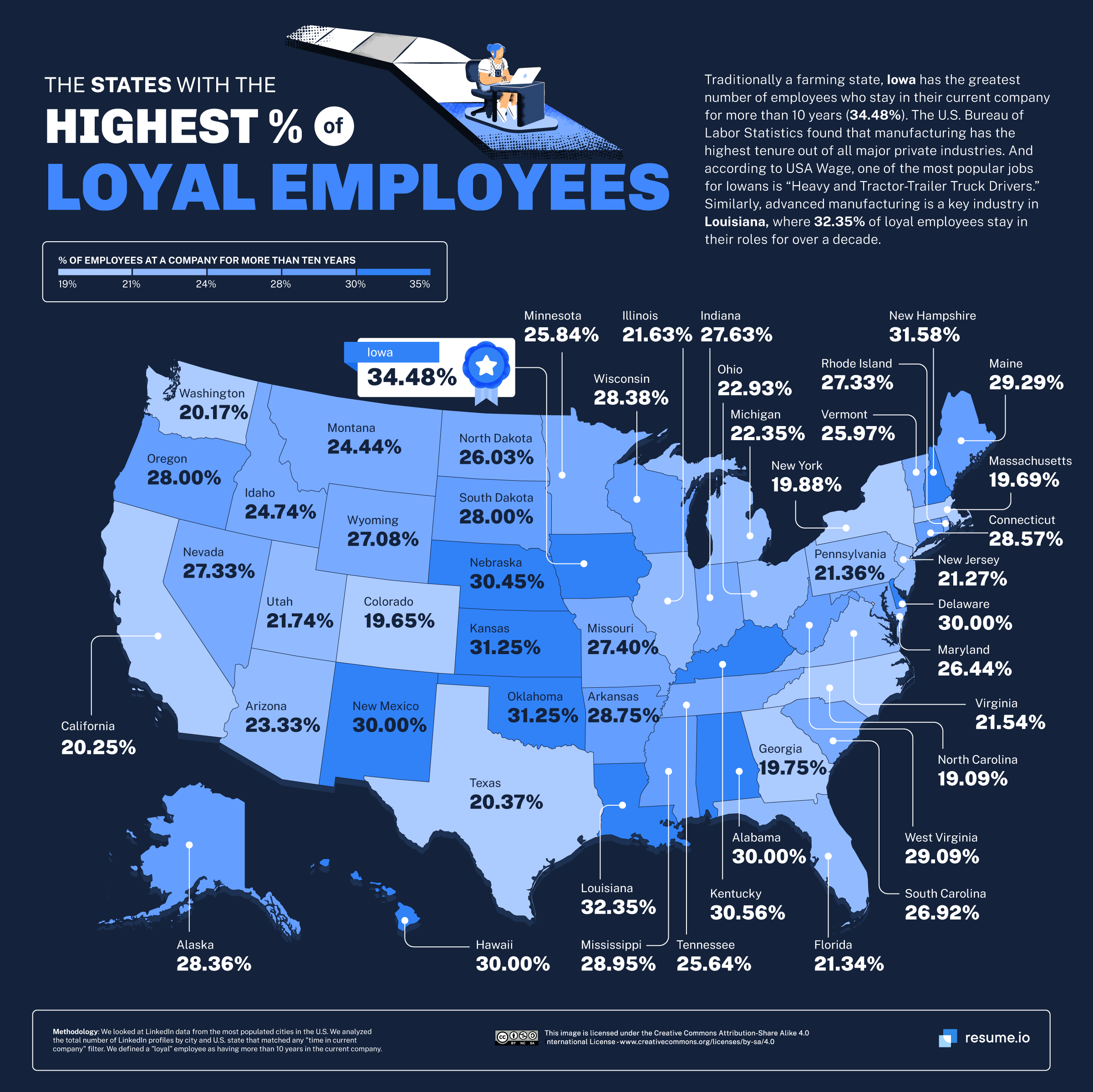
Click here to see the image in full size
Southern and midwest states foster the most loyal employees in the land. Around one-third of workers in Iowa, Louisiana, Kansas and Oklahoma have put in more than a decade with their current firm.
While some of these areas are actually short of workers, which you might expect to encourage job-hopping in an employee’s market, jobs here are often suitable for people who haven’t been to college — a demographic that tends to stay put in a job or at least in a locality. These blue-collar technical workers are also able to step into reasonably paid factory jobs straight from high school. They may stick at that job for years while receiving additional training at work or night school and accumulating the benefits of loyalty, such as healthcare and pensions.
Manchester and Bristol home to most UK job-hoppers
Job-hopping is more acceptable in the U.S. and UK than in other parts of the world, according to Michael Butler, who is head of HR for Bristol-based business consultancy Radius World Wide. “If you can get two years out of someone early on in their career, you are doing pretty well,” Butler told the BBC, adding that employees in their thirties or beyond should not switch more than twice in a decade. Bristol is home to the second highest level of job-hoppers in the UK; along with Manchester, the cities see around one-fifth of the workforce move on each year.
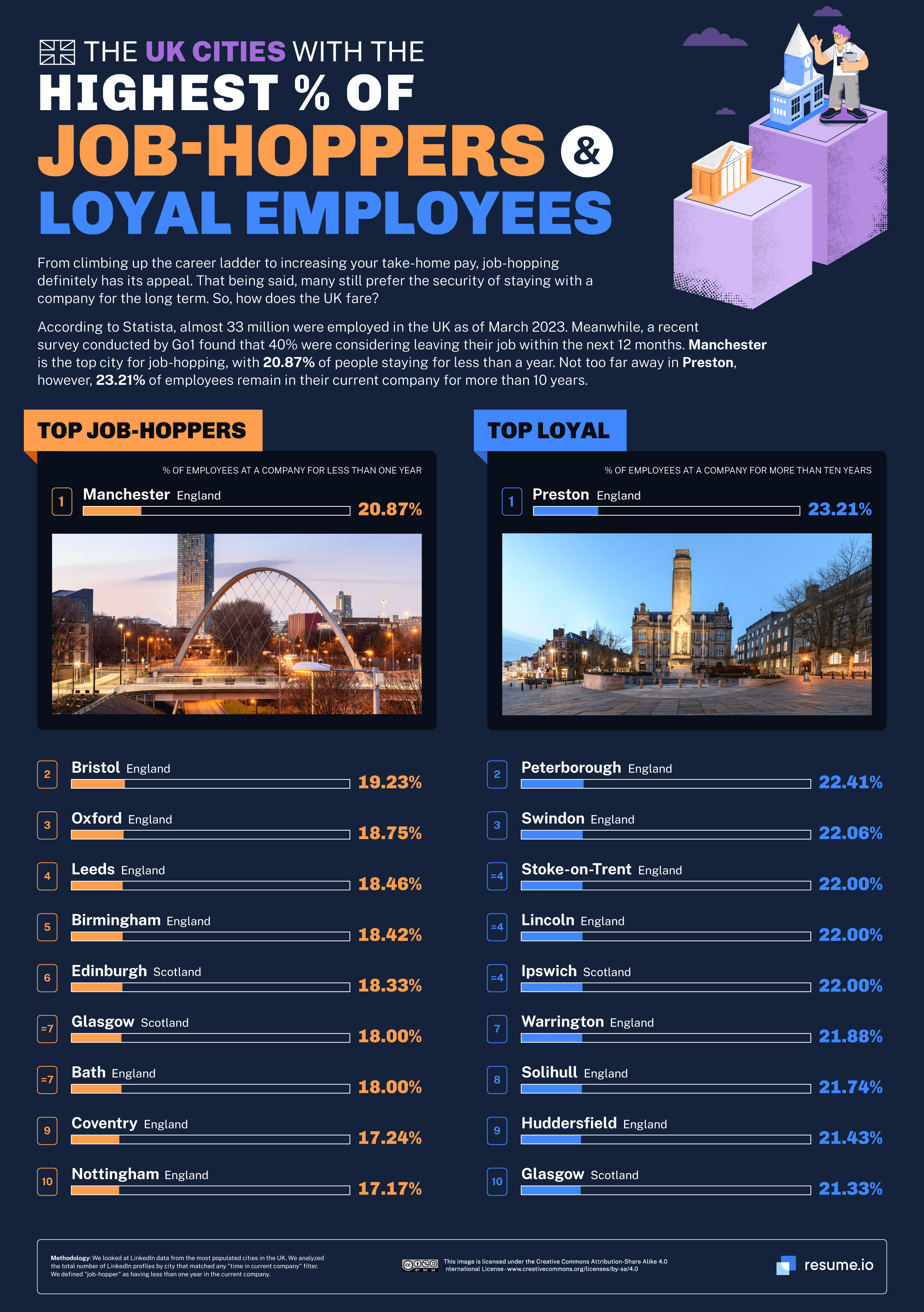
Click here to see the image in full size
While several of the UK’s highest-population cities are among its job-hopping hotspots, most of the cities with the most loyal employees have a population of around a quarter-million or less. (Glasgow, population 635,000, is the glaring exception — and actually appears on both lists.)
Preston has a population of around 95,000 and the most loyal workforce in the UK. It was recently announced that one of the city’s biggest employers, the HMRC tax office, would remain open, having been under threat for several years. The HMRC employs 1,400 people in Preston, and turnover in the civil service, in general, is relatively low, despite reaching 13.6% in 2021-22.
Australians tempted by boomerang recruitment trend
Brisbane and Adelaide are among the top three in Australia for both job-hoppers and loyal employees. Australians traditionally prefer to hold onto a job for a long time, which may have kept wages down overall. But it is an employee’s market right now, freeing workers to pick and choose better conditions — or jump to a new role. The job-hopper/loyalty dichotomy is muddied in Australia by the appropriately named “boomerang employee” trend of rehiring former colleagues to minimize recruitment and onboarding costs.
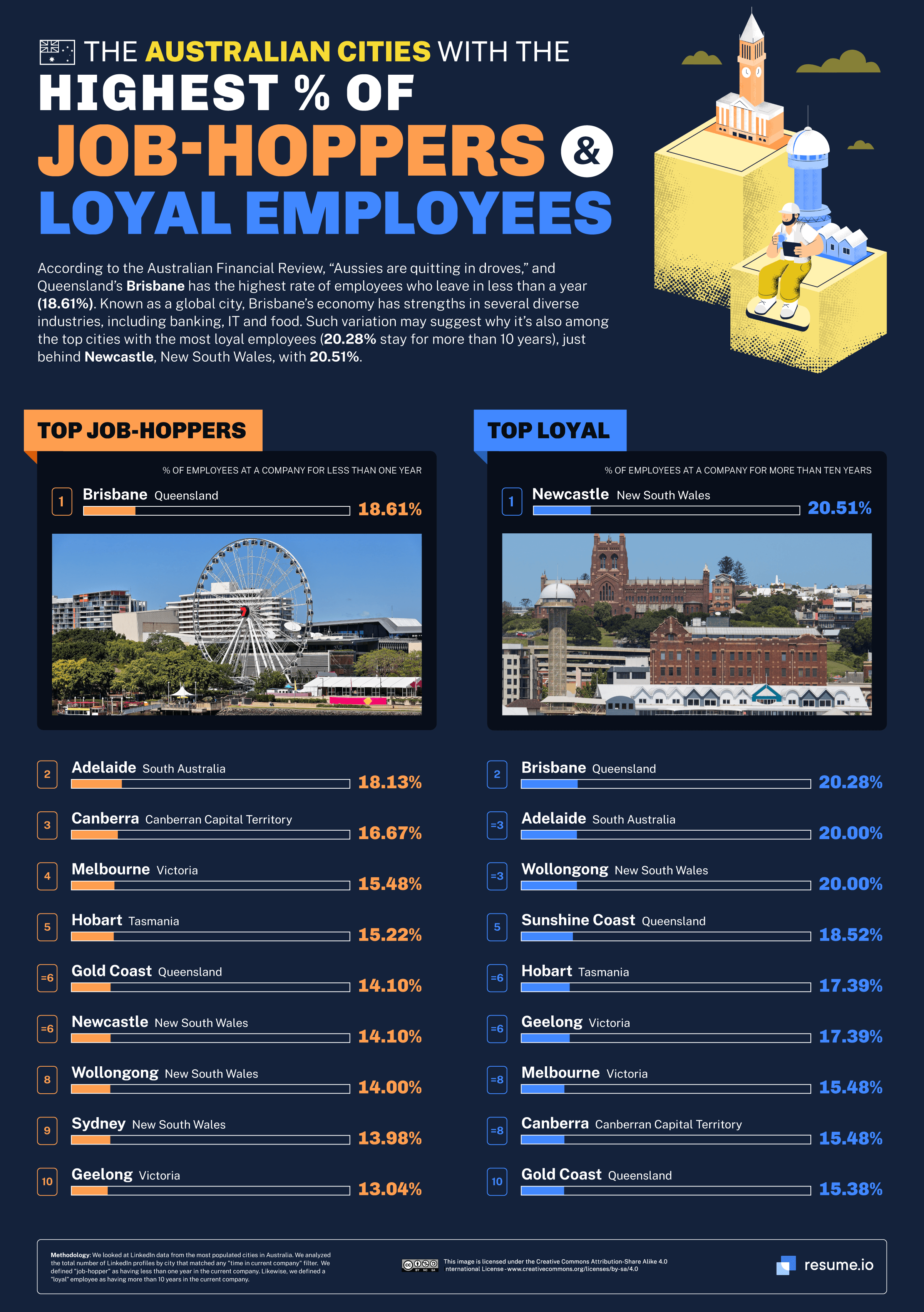
Click here to see the image in full size
The boomerang employee is ideally placed to negotiate a role for themselves that may play out well over a number of years — now they are assured of the value to their employer. “The great jobs boom is certainly happening,” says Elyssia Clark, head of customer insights and strategy at Australian jobs site Seek. “Candidates are increasingly aware of it, and we are seeing more conversations around salary than in the past. Organizations are finding they need a really strong value proposition and must be able to clearly articulate why a candidate should join them.”
Vancouver is Canada’s job-hopping capital
Vancouver and Montreal stand out as the job-hopping capitals of Canada, with neither city appearing among the top ten cities for loyalty. The Great Resignation never really hit Canada, with the number of job-leavers actually falling in 2020 and 2021 and remaining lower in February 2022 than it was in the weeks before the lockdown two years previously. However, Vancouver’s tech industry is growing at a rate of 6% year on year, stirring a pool of around 75,000 local tech workers to try new pastures.
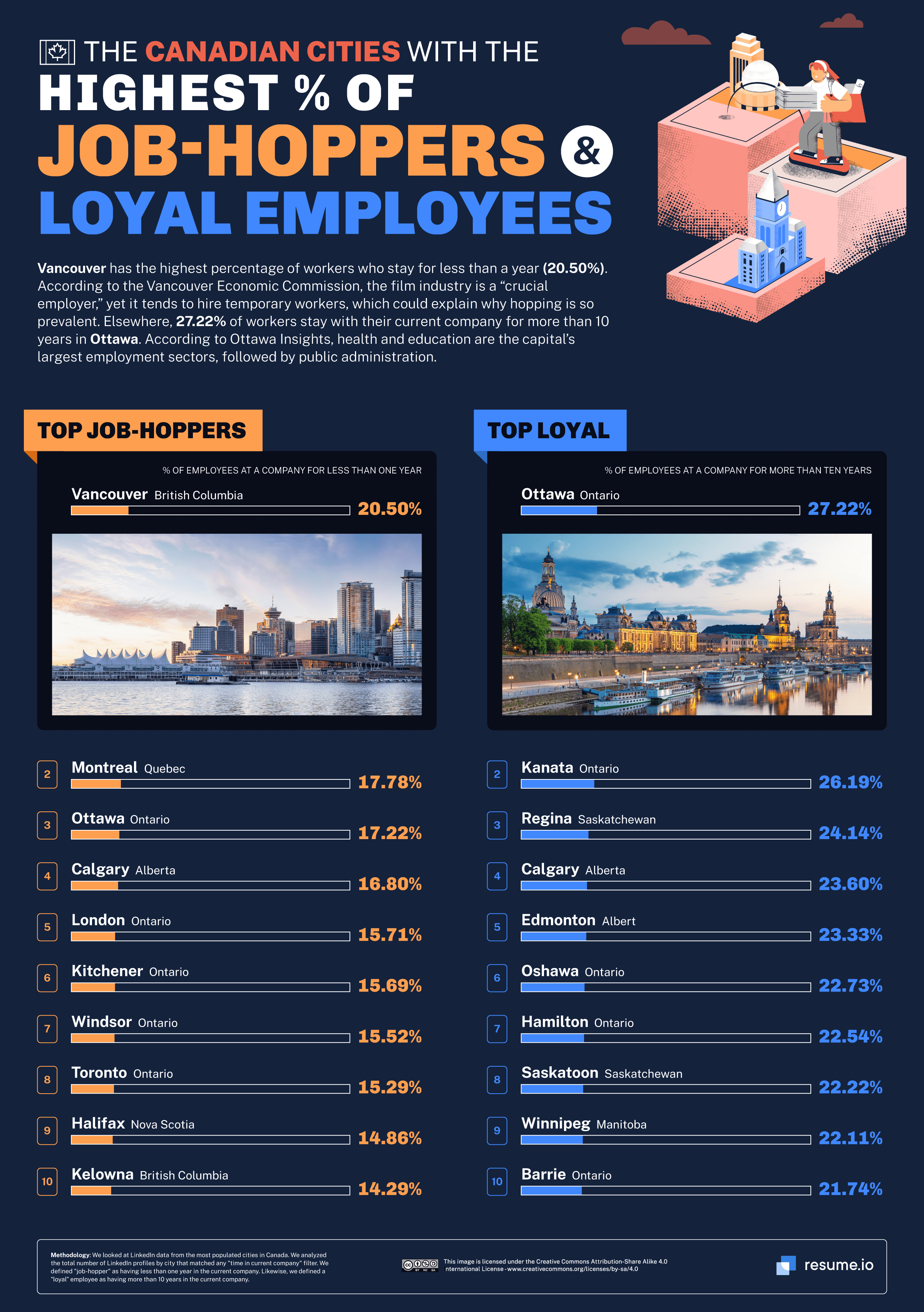
Click here to see the image in full size
Over a quarter of Ottawa employees have been in their role for over a decade, making it the Canadian capital of loyalty. But Ottawa also has an annual turnover rate of 17.22%, putting it just Vancouver and Montreal for job-hopping.
A suit that fits
For young professionals, job-hopping appeals not only for its professional advantages but also thanks to the appeal of a quick bump in earnings. But quitting for a new role is not a decision to take lightly. And embracing job-hopping should only be pursued as a deliberate and achievable career strategy — or it could backfire in terms of reputation and pay.
You can find our full data on the job-hopping capitals of the U.S., UK, Australia and Canada in the interactive table below.
While job-hoppers enjoy faster earning growth, perhaps because job-hopping is prevalent among early-career professionals, longer-term employees have higher earnings in absolute terms and may enjoy better benefits such as pensions. When thinking about moving on after less than a couple of years in a role, your choice whether to cool it or blow should be based on a broad range of values.
Methodology & sources
To determine which cities are the job-hopping and loyal employee capitals in the UK, U.S., Australia and Canada, we looked at LinkedIn data from the most populated cities in those countries.
We started by looking at the total number of LinkedIn profiles by city and U.S. state that matched any "time in current company" filter. Then, we defined "job-hopper" as having less than one year in the current company. Likewise, we defined a "loyal” employee as having more than 10 years in the current company.
We extracted these figures from the analyzed cities and compared them with the total number of employed people on LinkedIn in each city. This process was mimicked to obtain data at the U.S. state level.
Finally, we ranked the cities within each country to obtain the cities with the highest proportion of "job-hoppers" and "loyal" workers.
Note: The LinkedIn search function rounds figures to the nearest thousand, so all figures above 1,000 have been rounded up. However, figures above one million have been manually obtained to keep accuracy and relevance, as those are rounded to the nearest million instead.
The data of this analysis is correct as of June 2023.





